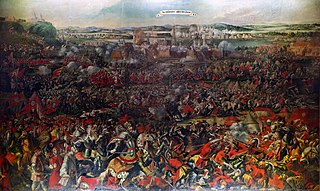
The Battle of Vienna took place at Kahlenberg Mountain near Vienna on 12 September 1683 after the city had been besieged by the Ottoman Empire for two months. The battle was fought by the Holy Roman Empire and the Polish–Lithuanian Commonwealth, both under the command of King John III Sobieski, against the Ottomans and their vassal and tributary states. The battle marked the first time the Commonwealth and the Holy Roman Empire had cooperated militarily against the Ottomans. The defeat was a turning point for Ottoman expansion into Europe, after which they would gain no further ground. In the ensuing war that lasted until 1699, the Ottomans would cede most of Ottoman Hungary to Leopold I, Holy Roman Emperor.

The Battle of Nördlingen, fought over two days from 5 to 6 September 1634, was a major battle of the Thirty Years' War. A Imperial-Spanish force led by the Cardinal-Infante Ferdinand and Ferdinand of Hungary inflicted a crushing defeat on the Swedish-German army led by Gustav Horn and Bernhard of Saxe-Weimar.

The Great Siege of Malta occurred in 1565 when the Ottoman Empire attempted to conquer the island of Malta, then held by the Knights Hospitaller. The siege lasted nearly four months, from 18 May to 8 September 1565.

The Battle of Albulena, also known as the Battle of Ujëbardha, was fought on 2 September 1457 between Albanian forces led by Skanderbeg and an Ottoman army under Isak bey Evrenoz and Skanderbeg's nephew, Hamza Kastrioti.

The Austro-Turkish War (1716–1718) was fought between Habsburg monarchy and the Ottoman Empire. The 1699 Treaty of Karlowitz was not an acceptable permanent agreement for the Ottoman Empire. Twelve years after Karlowitz, it began the long-term prospect of taking revenge for its defeat at the Battle of Vienna in 1683. First, the army of Turkish Grand Vizier Baltacı Mehmet defeated Peter the Great's Russian Army in the Russo-Turkish War (1710–1711). Then, during the Ottoman–Venetian War (1714–1718), Ottoman Grand Vizier Damat Ali reconquered the Morea from the Venetians. As the guarantor of the Treaty of Karlowitz, the Austrians threatened the Ottoman Empire, which caused it to declare war in April 1716.
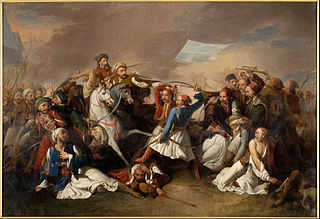
The Battle of Karpenisi took place near the town of Karpenisi on the night of 21 August 1823, between units of the Greek revolutionary army and Ottoman troops.
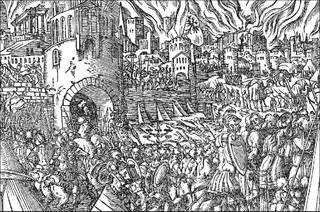
The First Siege of Krujë occurred in 1450 when an Ottoman army led by Sultan Murad II and his crown prince Mehmed II tried to besiege the Albanian town of Krujë. The League of Lezhë, led by Skanderbeg, experienced low morale after losing Svetigrad and Berat between 1448 and 1450. Nevertheless, Skanderbeg's exhortations and the support of the clergy, who claimed to have had visions of angels and victory, motivated the Albanians to defend the capital of the League, Krujë, at all costs. After leaving a protective garrison of 4,000 men under his trusted lieutenant Vrana Konti, Skanderbeg harassed the Ottoman camps around Krujë and attacked the supply caravans of Sultan Murad II's army. By September, the Ottoman camp was in disarray as morale sank and disease ran rampant. The Ottoman army acknowledged that the castle of Krujë would not fall by strength of arms, lifted the siege, and made its way to Edirne. Soon thereafter, in the winter of 1450–51, Murad died in Edirne and was succeeded by his son, Mehmed II.
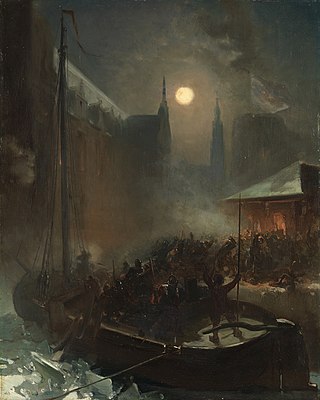
The capture of Breda was a short battle during the Eighty Years' War and Anglo–Spanish War during which a Dutch and English army led by Maurice of Nassau captured the heavily protected city of Breda. Using a clever tactic reminiscent of the Trojan horse which became famous as the ruse with the Turfschip van Breda, a small assault force hid in a peat barge, entered the city of Breda, and proceeded to take it over resulting in a minimum number of casualties. It was the turning point of the war as the forces under Maurice were able to take the offensive.

The Battle of Kallo was a major field battle fought from 20 to 21 June 1638 in and around the forts of Kallo and Verrebroek, located on the left bank of the Scheldt river, near Antwerp, during the second phase of the Eighty Years' War. Following the symbolic recovery of Breda during the 1637 campaign, the Dutch Republic agreed with the French Crown, with whom it had allied in 1635, to besiege a major city in the Spanish Netherlands during the 1638 campaign. The commander of the Dutch States Army, Frederick Henry of Orange, planned an approach over Antwerp from the two sides of the Scheldt. After marching the army, Frederick Henry transferred 50 barges to Count William of Nassau-Siegen and he was left entrusted to land in the Spanish-controlled Waasland region, west of Antwerp, to seize the forts of Kallo and Verrebroek, along with several other key fortifications, to invest Antwerp from the west. In the meantime, Frederick Henry would advance on the opposite bank to complete the blockade of the city while the armies of France invaded the Spanish Netherlands from the south to oblige the Spanish Army of Flanders to divide its forces.
Salah Rais was the 7th King of Algiers, an Ottoman privateer and admiral. He is alternatively referred to as Sala Reis, Salih Rais, Salek Rais and Cale Arraez in several European sources, particularly in Spain, France and Italy.

The Battle of Khotyn or Battle of Chocim or Khotyn War was a combined siege and series of battles which took place from 2 September to 9 October 1621 between a Polish–Lithuanian Commonwealth, commanded by the Grand Hetman of Lithuania Jan Karol Chodkiewicz, against an invading Ottoman Imperial army, led by Sultan Osman II, which was stopped until the first autumn snows. On 9 October, due to the lateness of the season and heavy losses - due to failed assaults on Commonwealth fortifications - the Ottomans abandoned their siege and the battle concluded with a stalemate, which is reflected in the treaty where some sections favour the Ottomans while others favoured the Commonwealth. Chodkiewicz died on 24 September 1621 shortly before concluding a treaty with the Turks.

Juan Del Águila (d'Aguila) y Arellano was a Spanish general. He commanded the Spanish expeditionary Tercio troops in Sicily then in Brittany, before serving as general of the Spanish armies in the invasion of Ireland (1600–1602). As a soldier, and subsequently Maestre de campo of the Tercios, he was posted to Sicily, Africa, Malta, Corsica, Milan, the Netherlands, Spain, Portugal, France and Ireland, where he participated in major military events of his time, such as the Siege of Malta, the Looting of Antwerp, the Siege of Antwerp, the "Miracle of Empel", an expedition in support of the French Catholics during the French Wars of Religion, the Raid on Mount's Bay and another one in support of Irish clans during the Nine Years War.

The siege of Svetigrad or Sfetigrad began on 14 May 1448 when an Ottoman army, led by Sultan Murad II, besieged the fortress of Svetigrad. After the many failed Ottoman expeditions into Albania against the League of Lezhë, a confederation of Albanian Principalities created in 1444 and headed by Skanderbeg, Murad II decided to march an army into Skanderbeg's dominions in order to capture the key Albanian fortress of Svetigrad. The fortress lay on an important route between present-day North Macedonia and Albania, and thus its occupation would give the Ottomans easy access into Albania.

Night combat is combat that occurs during the hours of darkness. It is distinguished from daytime combat by lower visibility and its reversed relation to the circadian cycle. Typically, night combat is favorable to the attacker, with offensive tactics being focused on exploiting the advantages to maximum effect. Defensive night tactics mainly focus on negating the advantages given by the night to the attacker.

The siege of Castelnuovo was an engagement during the Ottoman-Habsburg struggle for control of the Mediterranean, which took place in July 1539 at the walled town of Castelnuovo, present-day Herceg Novi, Montenegro. Castelnuovo had been conquered by elements of various Spanish tercios the year before during the failed campaign of the Holy League against the Ottoman Empire in Eastern Mediterranean waters. The walled town was besieged by land and sea by a powerful Ottoman army under Hayreddin Barbarossa, who offered an honourable surrender to the defenders. These terms were rejected by the Spanish commanding officer Francisco de Sarmiento and his captains even though they knew that the Holy League's fleet, defeated at the Battle of Preveza, could not relieve them. During the siege, Barbarossa's army suffered heavy losses due to the stubborn resistance of Sarmiento's men. Even the Venetian refused the promised naval link to Castelnuovo with the supplies and reinforcements; after a general troop parliament, the commanding officer Francisco de Sarmiento asked his captains what his answer should be to Barbarossa's offer to surrender. The captains responded: "Que vengan cuando quieran". However, Castelnuovo eventually fell into Ottoman hands and almost all the Spanish defenders, including Sarmiento, were killed. The loss of the town ended the Christian attempt to regain control of the Eastern Mediterranean. The courage displayed by the Old Tercio of Naples during this last stand, however, was praised and admired throughout Europe and was the subject of numerous poems and songs.

The siege of Leuven was an important siege in the Thirty Years' War in which a Franco-Dutch army under Frederick Henry of Orange and the French Marshals Urbain de Maillé-Brezé and Gaspard III de Coligny, who had invaded the Spanish Netherlands from two sides, laid siege to the city of Leuven, defended by a force of 4,000 comprising local citizen and student militias with Walloons, Germans, Spanish and Irish of the Army of Flanders under Anthonie Schetz, Baron of Grobbendonck. Poor organization and logistics and the spread of sickness among the French, along with the appearance of an Imperial-Spanish relief army of 11,000 under Cardinal-Infante Ferdinand and Ottavio Piccolomini, forced the invading army to lift the siege. This failure allowed the Spanish forces to take the initiative and soon the invaders were forced into a headlong retreat.
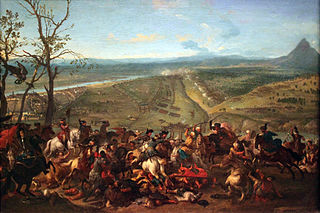
The siege of Belgrade was a successful attempt by Habsburg forces under the command of Prince Eugene of Savoy to capture the strategically important city of Belgrade from the Ottoman Empire. It took place during the Austro-Turkish War (1716–1718), barely a year after the Habsburg victory at the Battle of Petrovaradin (Peterwardein). The Imperial Army routed the Ottoman relief army under Grand Vizier Hacı Halil Pasha on 16 August. As a consequence, the Belgrade garrison, deprived of relief, surrendered to Habsburg forces on 21 August. The Ottoman Sultan Ahmed III sued for peace, resulting in the Treaty of Passarowitz a year later, which completed the transfer of the remainder of Hungary, the Banat of Temeswar with lower Syrmia, and the city of Belgrade with central Serbia into Habsburg hands.
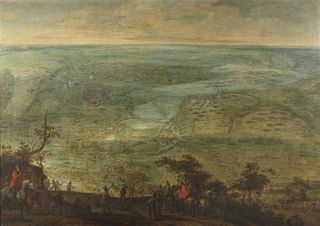
The siege of Saint-Omer was a siege in the Thirty Years' War in which a French army under Gaspard III de Coligny, Maréchal de Châtillon, laid siege to the Flemish city of Saint-Omer, defended by a small garrison in command of Lancelot II Schetz, count of Grobbendonck. Despite several initial successes in the capture of the minor forts around Saint-Omer, on the night of 8/9 June a Spanish relief army under Thomas Francis, Prince of Carignano, surprised Châtillon's troops and established a small fort in the middle of the French lines. An entire army corps under Maréchal de La Force was ordered to move towards Saint-Omer to support Châtillon siege, but on 12 July a further Imperial-Spanish force commanded by Ottavio Piccolomini entered Saint-Omer, resolving the French marshals to withdraw.

The siege of Coevorden was a siege that took place between 26 July and 2 September 1592 during the Eighty Years' War and the Anglo–Spanish War at the city of Coevorden by a Dutch and English force under overall command of Maurice of Nassau. The city was defended by Frederik van den Bergh who had been commissioned for the defence by King Philip II of Spain.

The Battle of Dobruja was fought during the Russo-Turkish War on 8 April to 4 September 1809 between Russian Empire and the Ottoman Empire.


















